March 25 - 31, 2018: Issue 353
The sydney Royal Easter Show showbag Began as an Australian sample Bag
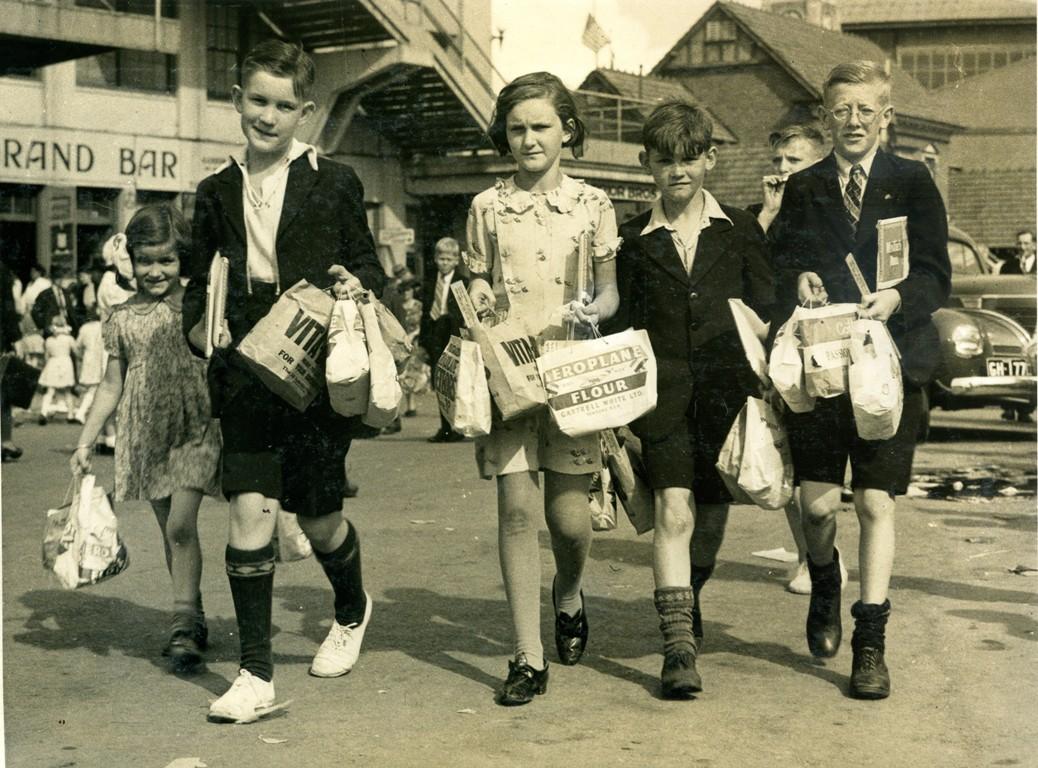
Sydney Royal Easter Show - children with their Show Bags, circa 1938.
Anyone who looks forward to collecting some great bags filled with goodies at the Royal Easter Show each year may be interested to know that the Showbag is yet another brilliant Australian idea that began as a 'sample bag'.
For generations, the Show has brought 'the country to the city', and it continues to be important, especially for children in Sydney. The showbag is one of the great ways to learn more about Australian products, as well as a once a year chance to overload on treats that may not form part of your everyday diet.
Originating at the Sydney Royal Easter Show sometime between 1909 and 1914, possibly by kiddie-favourites Gravox, the bags were originally given away by brands hoping to launch their wares by providing free samples of products. Food samples were handed out, and these were to evolve into 'sample bags'. By the late 1920s (1927), as the cost of producing bags became too much for companies, they began being sold;
At the show
By N. J. Myers.
'Ready, Con?'
'Righto! Just a minute, while I borrow Laura's powder. Duuno what's happened to mine !'
'Shake it up, then — we-haven't much time.'
Five minutes later Connie emerged from her bedroom, and we hurried off to the Royal Easter Show. It was two o'clock on Friday afternoon. ? Need I
mention it was Good Friday, and my young sister and I decided we were fed up of Mah Jongg and the wireless. Hence the visit to the Show.
'Gee ! Still raining. Nothing but rain, rain, rain ! Wish it would be fine for once,' gasped Con., as we hurried along under the folds of dad's sixteenribber umbrella.
We hopped on a tram, alighted at Regent-street, and hurried down to the Show. Sounds quick, doesn't it? but it was a quarter to three before we were actually there. I like going out with Con. She likes the things I do, and we have a jolly good muck-up. Do everything we shouldn't do ! We passed through one or two pig and cow pavilions. They weren't together, by the way ; but Con. didn't like them much; nor did I.
'Let's go and look round,' she suggested, .thinking, no doubt, of scent sprays and silk stockings.
'Let's.'
We strolled along past the machinery and small stalls. . ' -
'Oh ! look at those funny little buckets with the porridge or coffee or something in them?' cried Con.
'Do 'get me one.'
'Only one-and-sixpcnce,' lisped a sweet little voice.
I paid. We meandered round a store, stopped to hear 'On the Riviera,' in the gramophone shop, and politely inquired after some globes. We were soon mouth deep in buckets of ice cream, and munching biscuits.
Con. tried everything she could lay hands on, and even wanted to feel how bonax would taste after a glass of skimmed milk. I told her she really draw tho line somewhere. Soon the better part of a ten shilling note had gone west. Con. is expensive. Showbags full of samples, and chocolates and books, soon piled up in our hands as we visitod the various stalls.
Con. got disgusted when we came to an exhibit of woollen and silk goods. The apparel exhibited should have suited her, for it was feminine, but seven-eighths of the crowd around were men. I supposed the exhibitors were the draw — some nice, good-looking girls —but Con. didn't reply.
'Who'll sample a sandwich of peanut butter?' came from our right.
'Too right, I will!'
Con. was into that sandwich in a minute, and our show bags came away groaning a little more with jars of the old butter, and books telling how peanut butter saved the lives of two little boys from cannibals.
After an hour or two, during which Con. bought about six sets of powder and scents, and shaving-cream— sorry girls- don't shave yet — we adjourned to the park, at the side. Not without purchasing a few meat pies — Con. was hungry.
When we had polished off the pies we went round to see the Californian Giantess, the Snakologist, and the circus, and by then the evening was setting in.
We left by the Moore Park exit, when I remembered, to our sorrow, that I had only the bare sixpence for our tram fares home. After missing the right direction three times, we found our way down to Green's-rond, and eventually arrived home to find tea over, and the family gone to see a show.
At the SHOW (1927, April 24). Sunday Times (Sydney, NSW : 1895 - 1930), p. 3 (PRANKS THE CHILDREN'S NEWSPAPER). Retrieved from http://nla.gov.au/nla.news-article128511367
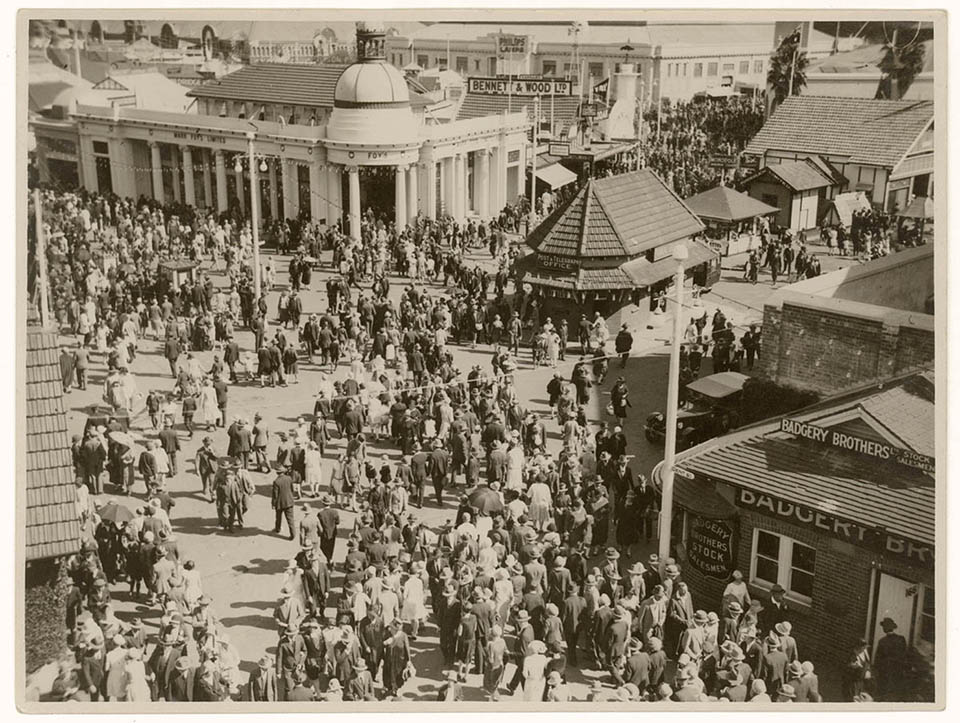
Crowds and pavilions, Royal Easter Show 1930s, State Library of New South Wales, Image No.: a359030h
IN SYDNEY AT EASTER THE ROYAL SHOW.
(From Our Own Representative.)
Sydney's leading weekly journal, 'The Sydney Mail,' is devoting three issues to illustrating and describing the great Easter Show, so that my readers will appreciate that, within the limits of the space available to me, I cannot do more than give some impressions of the big function from the point of view of a visitor from Riverina. The day on which I spent the greatest amount of time there was Good Friday, which is one of the days upon which the greatest attendances are registered. This year, so far, the records of the attendances do not seem to have been disclosed to the press. Regular habitues say they have not been as great as usual owing to the depression, and the consequent absence of visitors from the Inland. Be that as it may, it was difficult to move about on Good Friday. It was still more difficult to get a seat in any of the stands.
However, there was a consensus of opinion that the crowd was not as big as it had been in some previous years. In addition to the depression, there was the counter attraction of the wreck of the Malabar. This latter was something unique. There have been many wrecks along the coast of New South Wales, but not since the wreck of the Dunbar has there been one so close to Sydney, and one that could be. reached so readily as the catastrophe at Long Bay. I heard a gentleman at the hotel say, 'I went to the wreck. I 'can see a show any day, but I am 'nearly sixty and have never had a 'chance of seeing a good wreck be'fore.' Although this gentleman called it a 'good' wreck, most people allude to it as a 'bad' wreck, but — No more can be said on such a point as pending the inquiry the matter is sub judice. For years past visitors to Sydney have been taken to The Gap, and shown the place where the Dunbar was wrecked. Henry Lawson, in one of his short stories, tells humorously how the attention of passengers on out-going steamers was persistently directed to the place 'where the Dunbar was wrecked.' But that took place half a century ago, and the number of people who were living in Sydney at that time and still survive is relatively few. The wreck of the Malabar will oust the wreck of the Dunbar, as a topic of coastal catastrophe, just as Sir Clirystopher, The Dimmer, and Phar Lap have ousted The Barb, Grand Flaueur, and Carbine as a theme of discussion in sporting circles. Cargo from the wreckage has been strewn all along the coast about Sydney, even as far from the scene as Manly. And the police have not been able to stove in all the liquor kegs which have been rescued from the waves.
But to get back to the showground. In very many respects, the Royal Show is a country show, magnified a few times. The ring events are the same. The same sort of horses jump — some cleverly, some brilliantly, and many only at the third time of asking.
...
Quite half the show is not competitive, but a mere business display. All the same it is most interesting, even more so than the ring to many. Nearly all the big retailers have building of their own in which goods are displayed — practically shops away from the streets. In the second big pavilion, various firms have well appointed stalls, some of them showing attractive novel features. One of these which attracted a lot of attention was a miniature cisrarette factory. There was the machine which made cigs. working at full capacity. The cut-up tobacco was heaped in one huge funnel, the paper was placed in another receptacle, and the cigaretts were turned out of a big slot faster than one could count them. Girls, with agile fingers, were placing the cigarettes into packets. It was difficult to get near this stand at any time, even to buy the finished product. And there were plenty of buyers for the freshly made cigs. Another similar stand was one in which Minties were being made.' Here also machinery played the chief part. There was a man handling a great lump of Mintie toffee and pulling it out into white ropes, but he was merely a draw to catch the eye. The Minties were made and wrapped by machinery. The chocolate firms also had stands which attracted a lot of notice. At all these stands one could buy the products at a concession price, and get a paper basket bag to carry them away in. Similar bags were available for free samples, and many children thought the object of the show was to enable them to fill free basket bags with gratuitous samples, sweets preferred....
IN SYDNEY AT EASTER (1931, April 10). The Riverine Grazier (Hay, NSW : 1873 - 1954), p. 2. Retrieved from http://nla.gov.au/nla.news-article140658401
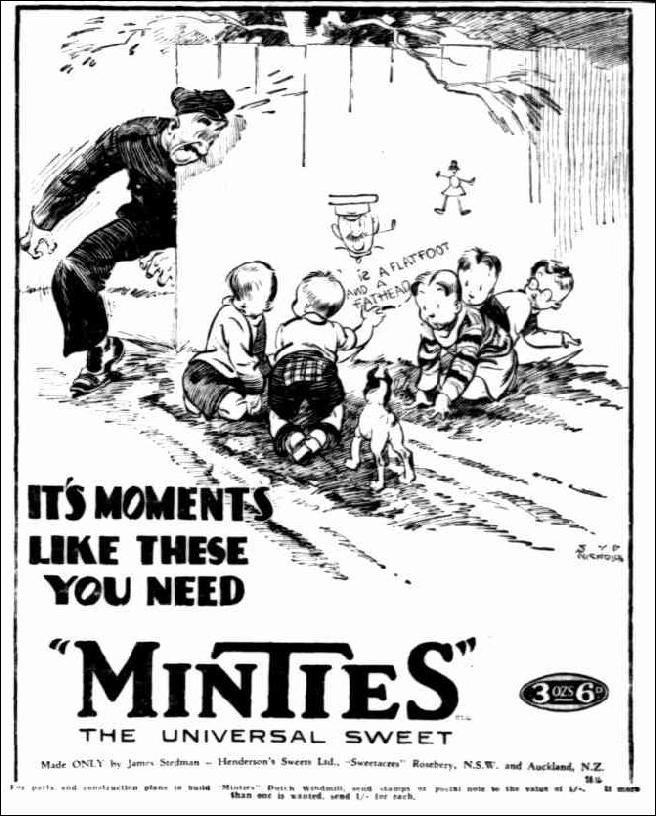
Minties 1938 advertisement - sourced from TROVE
Over the years, showbags have contained both the weird and the wonderful. The first ones mainly contained delicious food products with confectionery being particularly popular. Products, such as coal and laxatives, were once included.
With 1.2 million people visiting the show in 1947, the 'sample bags' became big business. In 1962, the Royal Agricultural Society “thoroughly investigate[d] the matter of sample bag prices” in order to keep vendors scrupulous. Since then, they’ve become one of the ongoing highlights of everyone’s visit to the show.
In the 1950s, toys made their way into the bags, although they were still called 'sample bags' then, as they are today in many cases. The market was flooded by big-name brands Violet Crumble, Weet-Bix, Giant Brand Licorice, and Rosella in the ’40s, Minties, and Lifesavers in the ’50s, and Sunny-Boy in the ’60s.
SAMPLE BAGS FOR THE ROYAL SHOW
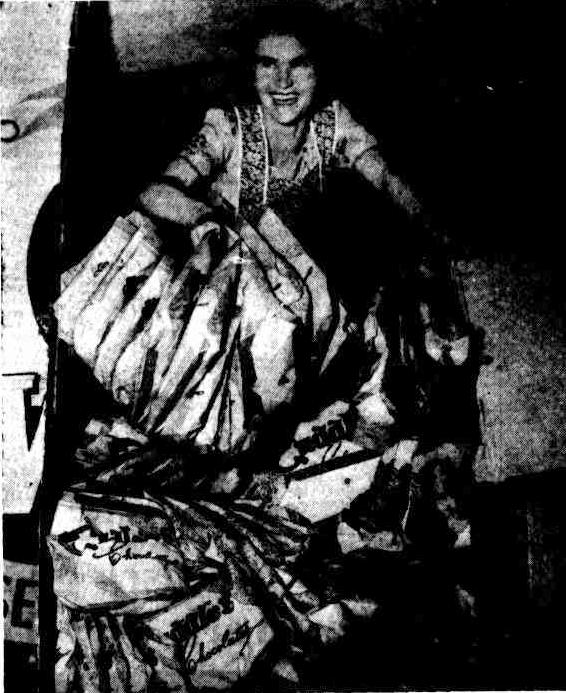
Mrs. Alice Brown unloading sample bags at the Showground yesterday, in readiness for the opening of the Royal Easter Show to-day.
SAMPLE BAGS FOR THE ROYAL SHOW (1951, March 16). The Sydney Morning Herald (NSW : 1842 - 1954), p. 1. Retrieved from http://nla.gov.au/nla.news-article18204222
A celebrity revolution took hold in the 1980s with Madonna and Michael Jackson bags introduced into the Showbag Hall.
By the mid-twentieth century, specialised showbags were available for purchase and have remained an important aspect of the Show experience, especially for children.
While topping off three dagwood dogs and a small raincloud of fairy floss with 25 Minities, a good handful of Bertie Beetles, all washed down with a Sunnboy pyramidal didn't get time to get frozen ice-block while trooping home with half a dozen showbags, there’s more to the show than that once you mature past the iggle-oggle chocolate froggle years, or even if you choose not to mature past way too much 'sampling' - at least admit you are a tad older and your oggles may boggle in a wider range.
Last year, the original stables were refurbished and this year are now filled with amazing food, and there are also bars to lounge in if you’ve been on one too many rides and the Show Stopper Craft beer, brewed by Mona Vale's Modus Operandi, surely superlatives are not needed about what excellence comes out of there by now. Atop this is a heap of free music to party to this year, with local faves like Akuou and YesYou hosting a neon-drenched silent disco.
The Show has many entertainments nowadays but for many of us it's all the country displays, wonderful animals and central arena parade or other ringside events that will bring us back time and again to the RAS Royal Easter Show...oh, and the showbags...there's 37 pages of them listed on the Sydney Royal Easter Show website...so you may come home with one, or two....
The 2018 Sydney Royal Easter Show will begin on Friday March 23, and ends on Tuesday April 3. You can peruse available showbags for 2018 here and, as seen below, these bags full of samples and 'treats' is not just attractive to youngsters!
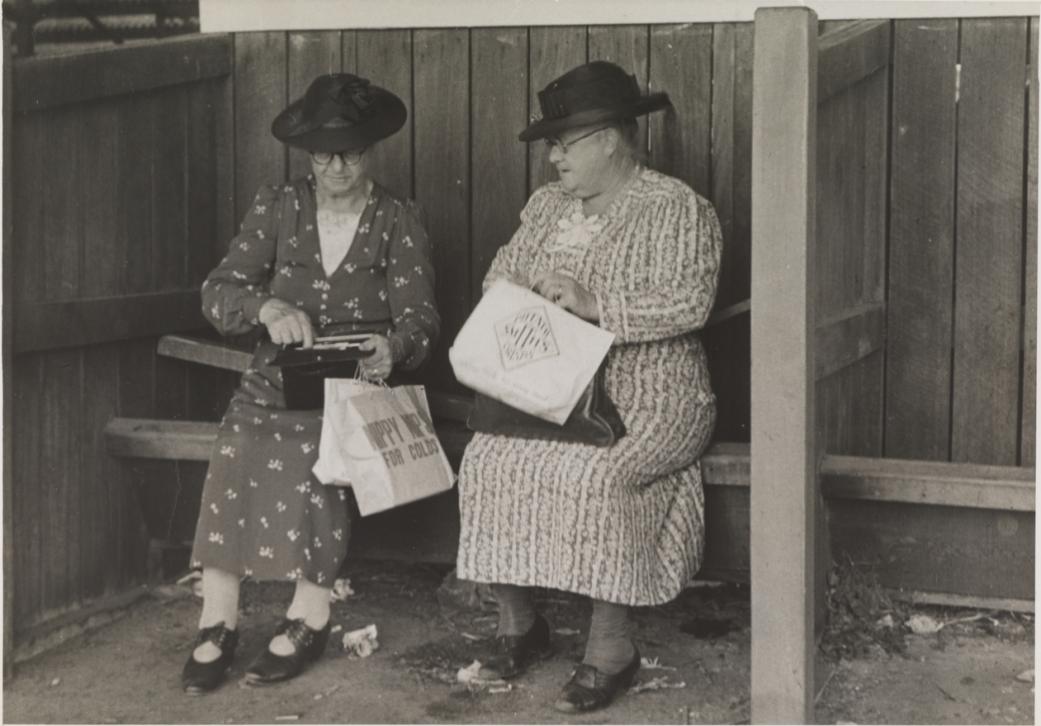
People at the "Show" circa 1925 to 1955, from album: Hood Collection part II : [Royal Agricultural Society Showground: Easter Shows, Sheep Shows, Highland gatherings, etc. (and including other agricultural industry scenes)] courtesy State Library of NSW, the Mitchell Library. Image No.: a359016h
The “Ag Bag” – The One Showbag That Will Make You Feel Good!!
March 21 2018: Royal Agricultural Society of NSW
Every year it is hot property and this year is no different – The “Ag Bag” goes on sale at the Sydney Royal Easter Show, every cent raised being returned to rural and regional NSW in the way of community projects.
The Ag Bag is proudly the invention of the Royal Agricultural Society of NSW Foundation or the RASF, the charitable arm of the not for profit RAS of NSW.
At just $20 with a value of more than $60, the Ag Bag is a showbag celebrating Australian agriculture and offers a range of products donated by Australian companies.
Across two days this month a dedicated team of volunteers packed 3500 bags ahead of the Sydney Royal Easter Show beginning this Friday, March 23.
“Everyone loves a Showbag, but taking home an Ag Bag leaves you knowing your well spent $20 will be directed entirely to community projects in rural and regional New South Wales,” said RAS Foundation Manager Cecilia Logan.
“It’s a feel good Showbag and we want to see every bag sold,” she said.
This Easter Show the RASF will again sell the Ag Bag from a location outside the iconic CWA Tea Room in the Home and Lifestyle Pavilion.
Projects funded by the RASF in the past year include:
- Dungog High School - Farmbot - STEM in Agriculture - $8450.
- Kyogle Pony Club - Fencing for Kyogle Showground Multipurpose Area - $12,624.
- Burren Junction Hall Committee – Restoration of Supper Room at Burren Junction Hall - $25,000.
- Coonabarabran Pastoral Agricultural, Industrial and Horticultural Association - Cattle and Horse Pavilion for Coonabarabran Showground - $25,000.
- Walgett Jockey Club – Transformation of Gordon Pavilion Community Hall - $25,000.
Products in the Sunrice sponsored 2018 Ag Bag include:
Kurrajong Kitchen Lavosh Bites 145g
Carmen's Bliss Balls Almond, Super Seed & Vanilla 45g
Breakfast in a Bag Choc-lish - Muesli 60g
SPC Bean Pots 175g
Go Natural Nut Delight Chopped 35g
Staminade Lemon Lime Sachet x 2 22.75 per sachet
SunRice Steamed Rice (Microwave Rice) 250g
Royston Petrie Seeds Tomato Urbana 10g
Roasted Fav-va Beans Tomato Onion & Basil 25g packs
2017 Australian Country Magazine 350g
Australian Country Diary 350g
Vegesorb sachet 10g
Tucker’s Natural Supergrains Snack Bites 25g
Australia Made Bumper Sticker
Buck Off Melanoma SPF50 Sunscreen 10g
RAS Times Magazine 135g
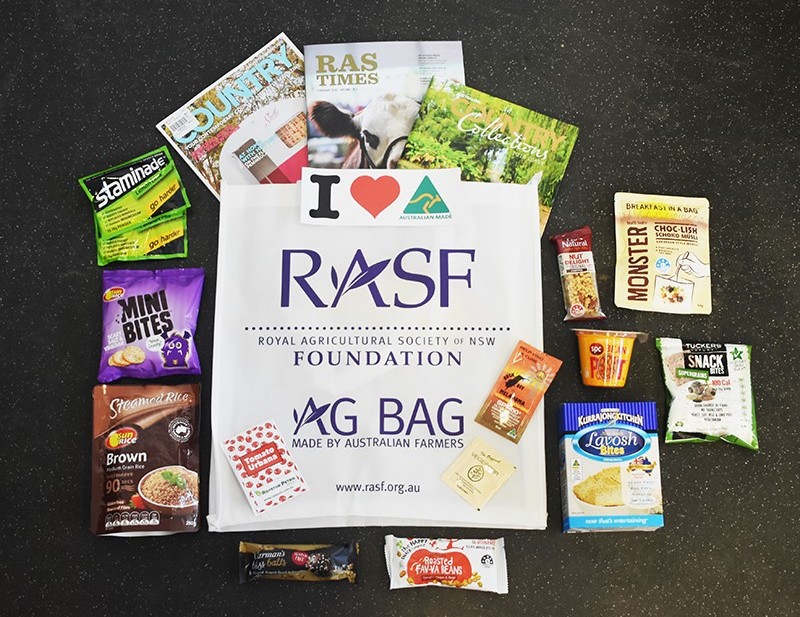
Further Reading
Roche Family of Bay View - 2015:
The Late Agricultural Show. We regret that we omitted to record in the prize list of the late Sydney Agricultural Show the fact that Mr. J. J. Roche, Bayview, Pittwater, won first prize in preserved fruit in syrup, beating some very choice collections. Mr. Roche also secured second prize in mandarin oranges. Mr. Roche is the owner of a very fine Orchard and poultry farm at Bayview, Pittwater, and he writes that he is bottling his peaches and apricots, and makes it pay well, and in his opinion it is the only way to make fruit pay at the present prices. The Late Agricultural Show. (1895, May 4). Australian Town and Country Journal (Sydney, NSW : 1870 - 1907), p. 48. Retrieved from http://nla.gov.au/nla.news-article71229161
Ships Biscuits - The At Sea Necessity That Floated William Arnott’s Success - Royal Easter Show Exhibitors - 2016
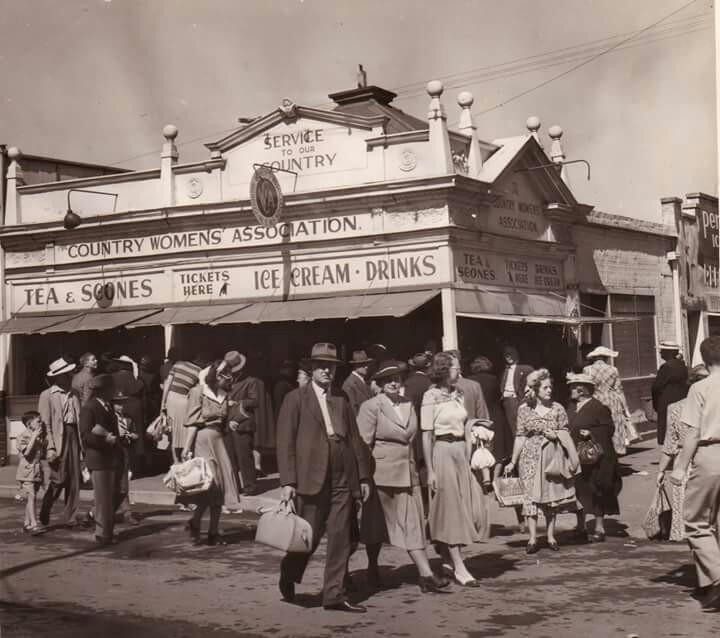
The original kiosk for the Country Women's Association of NSW at Sydney's, Royal Easter Show in 1948.
Easter Saturday Grand Parade
In the arena at the centre of the Moore Park Showground, livestock were judged, and equestrian events and special attractions held. In 1907 the Grand Parade was introduced, becoming an increasingly elaborate display of almost 800 prize-winning goats, cattle and horses. From the 1930s, rodeo activities became a regular feature of the ring.
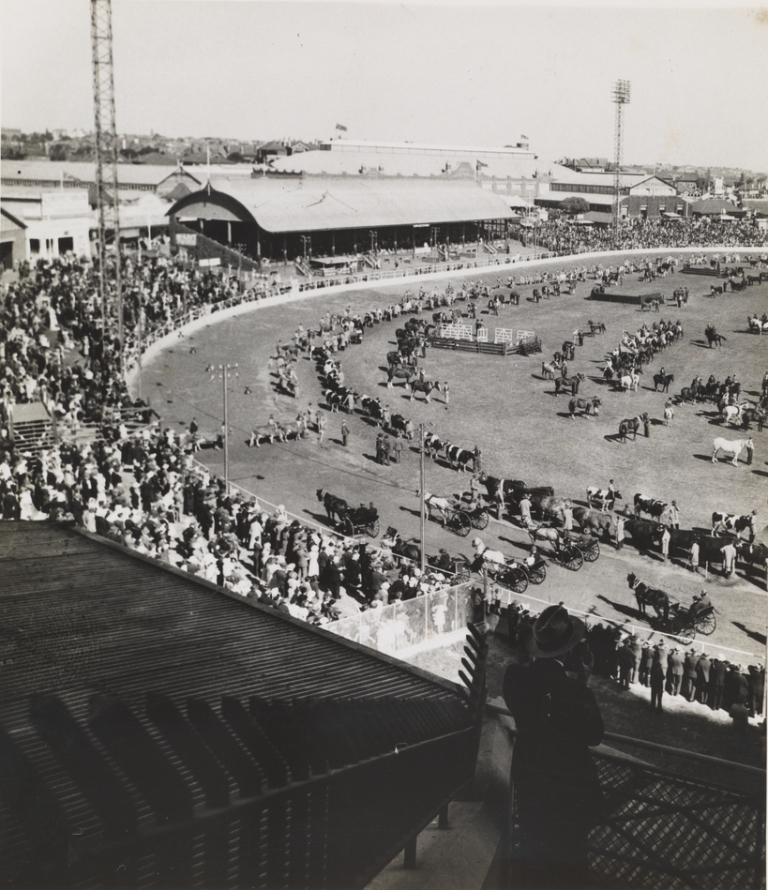
Grand parade, Easter Show, circa 1925 to 1955, from album: Hood Collection part II : [Royal Agricultural Society Showground: Easter Shows, Sheep Shows, Highland gatherings, etc. (and including other agricultural industry scenes)] courtesy State Library of NSW, the Mitchell Library. Image No.: a359002h
To the public eye, this spectacular sight, which involved and involves creatures ranging from newborn lambs and Shetland ponies to Brahman bulls and Clydesdale stallions, was staged with such skill that it invariably took place without a hitch. However, on one memorable occasion a steer broke loose and plunged into the quarters of the Royal Agricultural Society.
The Grand Parade continues to take place, even if on a smaller scale, at the Sydney Showground Stadium.
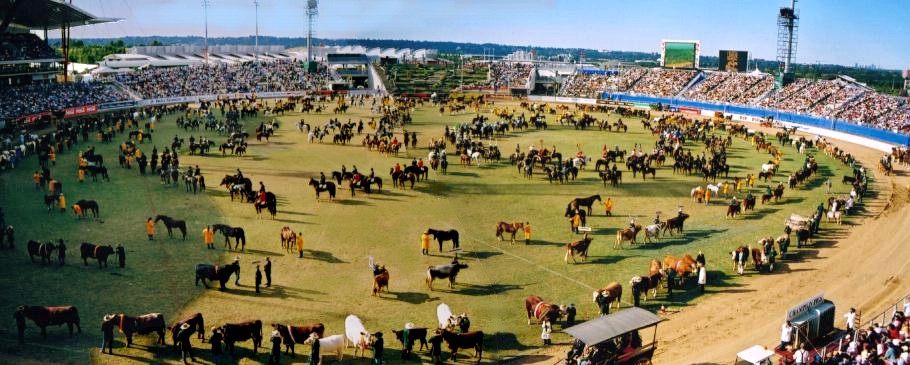
The Grand Parade at the showground at Sydney Showground Stadium, 2001. Photo by and Courtesy T Taylor
2018 Grand Parade
Where: Spotless Stadium
When: 24 March 5.20pm, 26 March 4.30pm, 30 March 4.25pm
This iconic event has been taking place at the Show since 1907. Watch as the best of the best in Australian agriculture make their way around Spotless Stadium in a spectacular procession.
The Grand Parade is an opportunity to pay silent homage to Sydney Royal Competition winners including animals, producers, champion wood-choppers, and future community leaders in a celebration of Australian agriculture. Why silent? The four-legged participants are more used to the serene peace and quiet of life on the farm, so give them a friendly wave and hold the applause until after they have left the stadium!
The Sydney Royal Easter Show Grand Parade is believed to be the first of its kind in the world and has been copied by every major agricultural show in Australia. The Grand Parade is the defining moment of the Australian agricultural show.
The Royal Easter Show was also the site of commercial exchanges and the celebration of Australian inventions and products. Demonstrations and sale of agricultural innovations and machinery were important up to the 1960s.